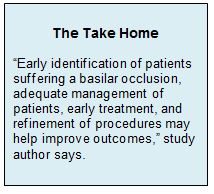Key Points:
- Study homes in on mechanical thrombectomy for basilar vs anterior circulation occlusions
- Basilar occlusion procedures take longer, have poorer outcomes with possibly more complications

Lead author María Alonso de Leciñana, MD, of the University Hospital, Paseo de La Castellana (Madrid, Spain), explained to NVX in an email that the “basilar artery is unique, with almost no collaterals in certain segments to supply vital structures within the brain and the main neural pathways in the brainstem. So, patients with basilar occlusions usually arrive at the hospital in very poor clinical condition.”
Basilar occlusion strokes do not always present with classic stroke symptoms, which can delay treatment, she noted. In particular, patients who present with sudden loss of consciousness will typically undergo intubation, which can complicate or delay appropriate care.
Dr. Alonso de Leciñana and her colleagues compared the outcomes and complication rates of mechanical thrombectomy in 479 patients treated for occlusions in the basilar artery (n = 52) or the anterior circulation (n =427). Their findings are published online December 20, 2016, ahead of print in the Journal of NeuroInterventional Surgery.
Both time to reperfusion and procedure duration were longer for patients with basilar artery occlusions. The basilar group also had a lower recanalization rate and a trend toward more procedural complications. The proportion of patients who were independent at 3 months (mRS score 0-2) was lower and the 3-month mortality rate higher for those with basilar occlusions. Moreover, the futile recanalization (resulting in “death or dependency at 3 months”) was more common in the basilar group (table 1).
Table 1. Outcomes and Complications by Occlusion Location
|
|
Basilar (n= 427) |
Anterior (n =92) |
P Value |
|
Median Onset-to-Reperfusion Time, mins |
385 |
315 |
.001 |
|
Median Procedure Duration, mins |
100 (40-130) |
60 (39-90) |
.006 |
|
Recanalization |
75% |
84% |
.01 |
|
Procedural Complication Rate |
32% |
21% |
.075 |
|
Symptomatic Intracranial Hemorrhage |
2% |
5% |
.25 |
|
3-Month mRS 0-2 |
40% |
58% |
.016 |
|
3-Month Mortality |
33% |
12% |
.001 |
|
Futile Recanalization |
50% |
35% |
.05 |
Rarer Condition Means Less Experience, Training
Commenting on this study for NVX, Ulf Jensen-Kondering, MD, of the University Hospital of Schleswig-Holstein (Kiel, Germany), echoed Dr. Alonso de Leciñana’s opinion that basilar strokes have poorer outcomes because damage to the brain tissue occurs more rapidly and more extensively in these cases than in strokes of the anterior circulation.
Both physicians also agreed that, despite these poorer outcomes, intravenous thrombolysis in conjunction with mechanical thrombectomy remains the best treatment option. “There is no better approach than reperfusion, but reperfusion is not the only effective treatment,” said Dr. Alonso de Leciñana. “Proper management during the acute phase in specialized stroke units by trained personnel provides effective brain protection and helps improve outcomes. Thus, it should be ensured as a standard of care for every stroke patient.”
She speculated that, given the rarity of basilar strokes, neurointerventionalists may simply lack the necessary training and experience to achieve optimal outcomes. She suggested there may be a role for the use of advanced simulation models to train them more thoroughly.
“Early identification of patients suffering a basilar occlusion, adequate management of patients, early treatment, and refinement of procedures may help improve outcomes,” she added. “Emergency services should be made aware of the importance of this clinical situation and should consider it in the differential diagnosis.”
According to Dr. Jensen-Kondering, another important way to optimize outcomes of basilar strokes would be to identify clinically meaningful prognostic markers, such as collateral status.
Source:
Alonso de Leciñana M, Kawiorski MM, Ximénez-Carrillo Á, et al. Mechanical thrombectomy for basilar artery thrombosis: a comparison of outcomes with anterior circulation occlusions. J NeuroInterv Surg. 2016;Epub ahead of print.
Disclosures:
Drs. Alonso de Leciñana and Jensen-Kondering report no relevant conflicts of interest.

